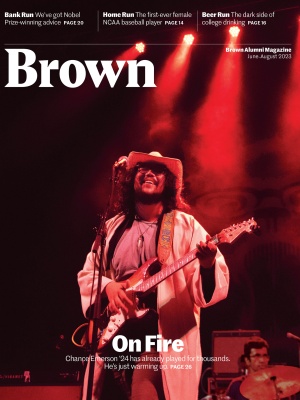
Twenty More for the Road
College is the place many people learn their limits with alcohol—and, sometimes, push way beyond them.
It was 10 p.m. when Dylan returned to his residence hall. A few minutes before, he’d been crowded into a stuffy freshman dorm room, pushed against the walls by students too tipsy to stand. With five of his floormates, Dylan took his sixth shot of the night. But after, sick of his gray basketball sweatsuit, he returned to his dorm to change—and, unbeknownst to his friends, took another 20 shots in the span of 15 minutes.
Stumbling downstairs he joined three of his floormates, prepared for another go at the night’s parties.
“I remember pushing open the door,” Dylan says, months later (we have changed his name to protect his identity). “The next thing I remember is waking up in a hospital bed.”
The summer before Brown, Dylan recalls drinking six to nine shots at a time, twice a week. That continued on campus. “Every weekend, I was looking to get drunk,” he says. Since his hospitalization, at least three of his friends have been brought to the same ER for excessive drinking.
Is information useless?
Most students are aware of the short-term risks of drinking: making poor judgments, failing to encode new memories, losing bodily control, and blacking out. At Brown, all incoming freshmen are required to take AlcoholEDU, a national training course.
“I had definitely heard of experiences with people going to the hospital,” Dylan says, “and my high school also had a bunch of guest speakers come in and tell their stories.”
Studies show AlcoholEDU has proven effective—and college drinking has been on the decline for decades. But risk assessment around alcohol remains hard, researchers agree. “For skydiving and playing chicken, it’s obvious what the actual dangers are,” says Steven Sloman, a professor of cognitive, linguistic, and psychological sciences, “whereas when you’re drinking, it’s easy to ignore them.”
One reason is that with drinking, possible consequences range from simply having a good time to sudden death from alcohol poisoning, says Kate B. Carey, a behavioral and social sciences professor in the School of Public Health. And the negative consequences are statistically less likely: “It’s a low enough probability that people are not factoring that in very highly,” Carey says.
Economics professor Emily Oster says humans are notoriously bad at understanding numerical risk. She says comparison can be a useful strategy—comparing the risks of one event to that of another more frequently discussed (like getting into a car accident). But Sloman, who also serves as advisor of the Behavioral Decision Sciences concentration, cautions that framing risk can be hard. “Getting hit by lightning may be more likely than getting bitten by a shark,” he says, “but people don’t know that because they’re bad with probability. You’re relying on one bad intuition to inform another.”
Hazy on the Details
After months of piecing together stories from his friends and parents, Dylan is still only partially able to recount the night’s events. He does know that he was too drunk to make it to the party. Instead, friends recruited six other freshmen to help carry Dylan—a six-foot-one, 180-pound basketball player—back to his dorm. The ten-minute walk took an hour and the group encountered Brown’s Department of Public Safety (DPS) twice. The first time, Dylan was able to answer officers’ questions. The second time, he was unconscious on the sidewalk, his friends unsure of what to do next. DPS called Brown Emergency Medical Services.
A variety of factors influence how people perceive their risk of bad outcomes. In general, people are more cognizant of short-term consequences because they have a greater effect on the present. “If people have something important to do tomorrow, they won’t tend to drink as much,” Carey says. Yet some consequences may even seem desirable: “If you black out, then you might have a funny story to tell the next day and all your peers would laugh,” Carey says. “So you might not think of a blackout as being that bad.”
Meanwhile, long-term risks—addiction, cognitive impairment, liver disease—can be hard for young people to grasp. “The younger the drinker, the less they factor in longer term outcomes,” Carey says. “[Adults] have more direct memories and experiences available to them that serve as warnings,” Sloman says. “They’re more sensitive to risks because they’ve experienced that more directly.”
The Sober Light of Morning
The first thing Dylan recalls after leaving his dorm room is waking briefly in the hospital. “I was very confused and still a little drunk,” he remembers. He still has no idea what the doctors did for him.
A few hours later, he came to again, this time in his parents’ hotel room—they happened to be in town for a Brown-Harvard football game. His first thought was “how would I talk to my parents?” Dylan says. He recalls feeling cold and, to his surprise, barely hung over. “I was focused on what I can say to make things better for people I may have embarrassed myself in front of or done something wrong to,” Dylan says.
Brown mandated counseling that, Dylan says, was very informative. “It definitely changed my perspective to be like, ‘Whoa, if people weren’t there to help me, it could have gone [badly], and it would have affected a lot of people around me, not just myself,’” he says.
After taking a month’s break, Dylan now drinks more cautiously. “It’s made me stay in more control,” he says. “I also have a higher level of compassion for people [in these situations] because I’ve been there before. I know what it’s like.”




